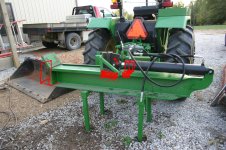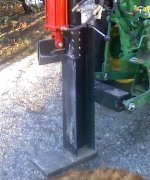AnthonyGarcia
New member
- Joined
- Oct 23, 2011
- Messages
- 4
- Tractor
- John Deere 5103 4wd
A friend & I enbarked on making out own log splitter, that hooks to my John Deere 5103 tractor. First afternoon of splitting logs shows up somethings wrong in our design. it peeled back the push against plate (1" plate steel) and cupped up the knife blade plate. see attatched pic. I was trying to split some smaller hedge (12" diam?) and frozen oak with it. I am exploring with SpeeCo on the valve if there is a adjustment to turn down its power a bit. All the 30ton log splitters we saw at stores had less bottom plate sizes.
Can someone provide thier expertise on what i need to do when rewelding and redesigning? The wood wanted to push up at the first and got worse of course as things got bent more. Whats the optimum hieght of the pin hole on the knife blade slide? So the cylinder pushes a little below horizontal into ibeam? a little above? or perfectly parrallel?
Please respond with advise


Can someone provide thier expertise on what i need to do when rewelding and redesigning? The wood wanted to push up at the first and got worse of course as things got bent more. Whats the optimum hieght of the pin hole on the knife blade slide? So the cylinder pushes a little below horizontal into ibeam? a little above? or perfectly parrallel?
Please respond with advise


